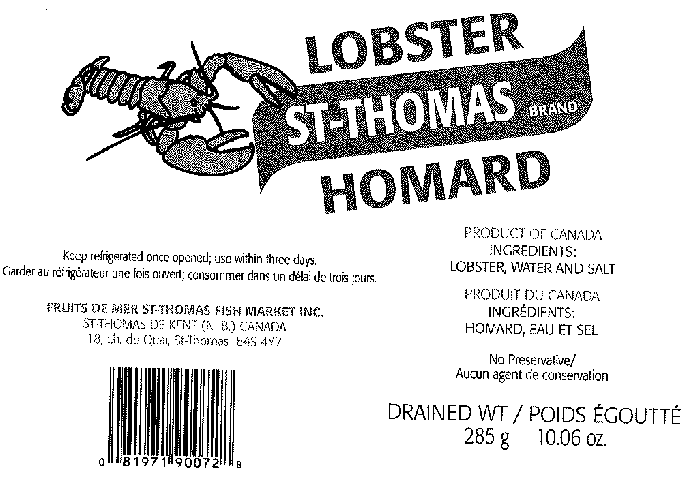
This is an update to my previous blogs:
Regarding the Canadian Food Inspection Agency’s ongoing food safety investigation and testing of seafood products from St. Thomas Fish Market Inc. (Saint-Thomas-De-Kent, New Brunswick, Canada), the recall update now includes the following additional product.
- The Canadian Food Inspection Agency (CFIA) is warning the public not to consume the bottled Lobster described below because it may be contaminated with Clostridium botulinum bacteria.
-
Toxins produced by these bacteria may cause botulism, a life-threatening illness.
-
| Brand Name | Common Name | Size | Codes(s) on Product | UPC |
|---|---|---|---|---|
| St.Thomas | Lobster | 285 g (drained weight) |
On cover of jar: 13921, 14021, 19121, 19521, 20221, 20521, and 20822 |
0 81971 90072 8 |
- CFIA’s Recall/Advisory date: April 6, 2013
- Hazard classification: Class 1
-
Class 1 is a situation in which there is a reasonable probability that the use of, or exposure to, a violative product will cause serious adverse health consequences or death.
-
- This product has been distributed for retail in:
-
New Brunswick
- National – may have been distributed in other provinces
-
Please note that food contaminated with Clostridium botulinum may not look or smell spoiled.
- In food borne botulism, symptoms generally begin 12 to 36 hours after eating a contaminated food, but they can occur as early as six hours or as late as 10 days.
Anyone who has consumed this product and experiences any of the symptoms described here should see a health care provider immediately and notify their local public health unit because death can occur in severe cases:
- nausea
- vomiting
- fatigue
- dizziness
- headache
- double vision
- dry throat
- respiratory failure
- paralysis
Contact Info
Canadian Food Inspection Agency (CFIA) at:
-
1-800-442-2342
-
TTY 1-800-465-7735
-
8:00 a.m. to 8:00 p.m. Eastern time, Monday to Friday
-
Or contact CFIA by filling out the online feedback form
Le texte français suit le texte anglais:
Did you know?
- The Canadian Food Inspection Agency issues public advisories and email notifications for food recalls for all high-risk food recalls (mainly Class I) when the product is available for sale or could be in consumers’ homes.
- All other recalls (Class II and III) and food products that are sold exclusively to restaurants, are posted on the CFIA’s Food Recall Report.
- Email notifications are also available for all allergen recalls.
- Food and consumer product recalls are also available at www.healthycanadians.gc.ca .

Canadian Food Inspection Agency
PUBLIC ADVISORY
Updated Health Hazard Alert – Certain St. Thomas brand Bottled Lobster may contain dangerous bacteria
Recall / advisory date: April 6, 2013
Reason for recall / advisory: Microbiological – Clostridium botulinum
Hazard classification: Class 1
Company / Firm: St-Thomas Fish Market Inc.
Distribution: New Brunswick, National
Extent of the distribution: Retail
Advisory details
Ottawa, April 6, 2013 – The public warning issued on March 23, 2013 has been updated to include an additional product because this product may be contaminated with Clostridium botulinum. Previously identified products included in this recall can be found on the Canadian Food Inspection Agency (CFIA) website.
The Canadian Food Inspection Agency (CFIA) is warning the public not to consume the bottled Lobster described below because it may be contaminated with Clostridium botulinum. Toxins produced by these bacteria may cause botulism, a life-threatening illness.
This product has been distributed in New Brunswick and may have been distributed in other provinces.
The CFIA is monitoring the effectiveness of the recall.
Affected products
| Brand Name | Common Name | Size | Codes(s) on Product | UPC |
|---|---|---|---|---|
| St.Thomas | Lobster | 285 g (drained weight) |
On cover of jar: 13921, 14021, 19121, 19521, 20221, 20521, and 20822 |
0 81971 90072 8 |
More information
For more information, consumers and industry can contact the CFIA by filling out the online feedback form.
Food contaminated with Clostridium botulinum toxin may not look or smell spoiled. Consumption of food contaminated with the toxin may cause nausea, vomiting, fatigue, dizziness, headache, double vision, dry throat, respiratory failure and paralysis. In severe cases of illness, people may die.
For more information on foodborne pathogens, visit the Causes of Food Poisoning web page.
L’Agence canadienne d’inspection des aliments (ACIA):
- Classification des rappels: Classe I
-
Classe 1correspond à une situation où il existe une probabilité raisonnable que l’utilisation d’un produit non conforme ou une exposition à celui-ci entraînera des effets nuisibles graves sur la santé, voire même la mort
-
- L’ACIA publie des mises en garde et envoie des avis par courriel sur les rappels d’aliments à risque élevé (principalement ceux de la classe 1) lorsque le produit est en vente ou pourrait se trouver chez les consommateurs.
- Tous les autres rappels (classe 2 et 3) ainsi que les produits vendus exclusivement aux restaurants sont publiés dans le Rapport sur les rappels d’aliments de l’ACIA. Les avis par courriel sont offerts pour tous les rappels d’aliments contenant des allergènes.
- Les rappels d’aliments et de produits de consommation sont aussi diffusés sur le site www.canadiensensante.gc.ca
Agence canadienne d’inspection des aliments
MISE EN GARDE PUBLIQUE
Mise à jour – Danger pour la santé – Présence possible d’une bactérie dangereuse dans certains bocaux de homard de marque St. Thomas
Date du rappel / avis : le 6 avril 2013
Raison de rappel / avis : Élément microbiologique – Clostridium botulinum
Classification du risque: Classe 1
Compagnie / entreprise: St-Thomas Fish Market Inc.
Distribution: Nouveau-Brunswick, Nationale
Étendue de la distribution: Détail
Détails du rappel
Ottawa, le 6 avril 2013 – La mise en garde diffusée le 23 mars 2013 a été modifiée pour inclure un autre produit qui pourrait être contaminé par la bactérie Clostridium botulinum. Les produits déjà visés par le rappel se trouvent sur le site Web de l’Agence canadienne d’inspection des aliments (ACIA).
L’ACIA avise la population de ne pas consommer le homard embouteillé décrit ci-dessous parce que ce produit pourrait être contaminé par la bactérie Clostridium botulinum. Les toxines produites par cette bactérie peuvent causer le botulisme, une maladie parfois mortelle.
Le produit a été distribué au Nouveau-Brunswick et pourrait l’avoir été dans d’autres provinces.
L’ACIA surveille l’efficacité du rappel.
Produits touchés
| Marques commerciales | Nom usuel | Format | Code(s) sur le produit | CUP |
|---|---|---|---|---|
| St.Thomas | Homard | 285 g (poids égoutté) |
Sur le couvercle du bocal : 13921, 14021, 19121, 19521, 20221, 20521, and 20822 |
0 81971 90072 8 |
Information supplémentaire
Pour de plus amples renseignements, les consommateurs et les gens de l’industrie peuvent communiquer avec l’ACIA en remplissant un formulaire de commentaires en ligne.
Les aliments contaminés par la bactérie Clostridium botulinum ne présentent pas nécessairement d’altération visible ni d’odeur suspecte. La consommation d’aliments contaminés par la toxine peut provoquer des nausées, des vomissements, de la fatigue, des étourdissements, des maux de tête, une vision double, un assèchement de la gorge, une insuffisance respiratoire et une paralysie. Dans les cas graves, la contamination par Clostridium botulinum peut causer la mort.
Pour de plus amples renseignements sur les agents pathogènes alimentaires, visitez le site Web sur les Causes d’empoisonnement alimentaire.
——————————————
You may also want to know:
